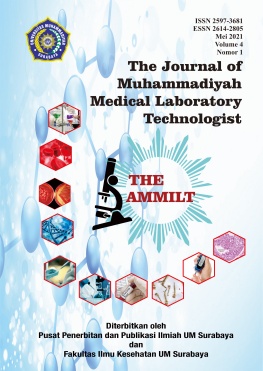Isi Artikel Utama
Abstrak
ABSTRACT
Â
Serum using is preferred for urea level because it does not use anticoagulants which can interfere with activity and reaction to the results. The tubes that are widely used to collect blood into serum are vacutainer serum separator and vacutainer plain.This researche aims to determine the degree of agreement s between vacutainer serum separator and vacutainer plain usage on serum urea level result.This research was cross sectional design and hold on October 2020 with subject were taken from thirty blood samples of health analyst students which taken randomly and had no history of disease or kidney function disorder. Each student was taken 6 ml of blood drawn using a venoject with each vacutainer containing 3 ml, so we had 60 data. The data were analyzed by descriptively and inferentially using the Interclass Correlation Coefficient (ICC) statistical test. From the descriptive analysis, the difference in mean levels was 0.35 mg/dL and the ICC statistical test resulted in a degree of agreement 0.745. The data were analyzed by descriptively and inferentially using the Interclass Correlation Coefficient (ICC) statistical test. From the descriptive analysis, the difference in mean levels was 0.35 mg/dL and the ICC statistical test resulted in a degree of agreement was 0.745. The calculation of the average working time between the vacutainer serum separator and the vacutainer plain was 4 minutes 38 seconds and 35 minutes 58 seconds. The analysis concluded that the vacutainer serum separator and the vacutainer plain could be used as an alternative of blood collecting tubes for urea level testing which proved to be no significant difference in the results from this research.
Â
Keywords : Urea level, Vacutainer Serum Separator, Vacutainer Plain
Rincian Artikel
Referensi
- Arslan, F. D. et al. (2017) ‘The local clinical validation of a new lithium heparin tube with a barrier: BD Vacutainer® Barricor LH Plasma tube’, Biochemia Medica, 27(3). doi: 10.11613/BM.2017.030706.
- Babakhani, B. et al. (2018) ‘A New Formulation for Polymeric Separator Gels for Potential use in Blood Serum Separator Tubes’, Progress in Rubber, Plastics and Recycling Technology, 34(1), pp. 35–53. doi: 10.1177/147776061803400103.
- Bowen, R. A. R. and Remaley, A. T. (2014) ‘Interferences from blood collection tube components on clinical chemistry assays’, Biochemia Medica, pp. 31–44. doi: 10.11613/BM.2014.006.
- Bush, V. (2012) ‘Effects of Pre-analytical Variables in Therapeutic Drug Monitoring’, in Therapeutic Drug Monitoring. Elsevier, pp. 31–48. doi: 10.1016/B978-0-12-385467-4.00002-6.
- Cuhadar, S. et al. (2012) ‘Stability studies of common biochemical analytes in serum separator tubes with or without gel barrier subjected to various storage conditions’, Biochemia Medica, pp. 202–214. doi: 10.11613/BM.2012.023.
- Fatma, R. Z., Martsiningsih, M. A. and Suryanta, S. (2019) Perbedaan Kadar Ureum Pada Plasma Lithium Heparin Dengan Penggunaan Separator Tube Dan Vacutainer Pada Pasien Post Hemodialisa. Poltekkes Kemenkes Yogyakarta. Available at: http://eprints.poltekkesjogja.ac.id/692/.
- Kösem, A. et al. (2020) ‘Comparison of some biochemical tests in different blood collection tubes in hemodialysis patients’, Turkish Journal of Biochemistry, 45(1), pp. 26–36. doi: 10.1515/tjb-2018-0341.
- Li, Z. et al. (2010) ‘Evaluation of BD vacutainer SSTTM II plus tubes for common tumor marker tests by Roche Diagnostics Modular E 170 analyzer’, Journal of Clinical Laboratory Analysis, 24(6), pp. 418–421. doi: 10.1002/jcla.20422.
- Lindh, W. Q. et al. (2013) Delmar’s Comprehensive Medical Assisting: Administrative and Clinical Competencies. Cengage Learning. Available at: https://books.google.co.id/books?id=oGaeq8Ftd3gC.
- Narayanan, S. (2000) ‘The Preanalytic Phase’, American Journal of Clinical Pathology, 113(3), pp. 429–452. doi: 10.1309/C0NM-Q7R0-LL2E-B3UY.
- Nursalam (2016) Konsep Dan Penerapan Metodologi Penelitian Ilmu Keperawatan. Jakarta: Salemba Medika.
- Sukorini (2010) Pemantapan Mutu Internal Laboratorium Klinik. Yogyakarta: Kanal Medika dan Alfamedia Citra.
- Verdiansah (2016) ‘Pemeriksaan Fungsi Ginjal’, Cermin Dunia Kedokteran, 43(2), pp. 148–154.
- Wei, Y. et al. (2010) ‘The Feasibility of Using Lithium-Heparin Plasma From a Gel Separator Tube as a Substitute for Serum in Clinical Biochemical Tests’, Laboratory Medicine, 41(4), pp. 215–219. doi: 10.1309/LMIXVAI70KS0UWQI.
Referensi
Arslan, F. D. et al. (2017) ‘The local clinical validation of a new lithium heparin tube with a barrier: BD Vacutainer® Barricor LH Plasma tube’, Biochemia Medica, 27(3). doi: 10.11613/BM.2017.030706.
Babakhani, B. et al. (2018) ‘A New Formulation for Polymeric Separator Gels for Potential use in Blood Serum Separator Tubes’, Progress in Rubber, Plastics and Recycling Technology, 34(1), pp. 35–53. doi: 10.1177/147776061803400103.
Bowen, R. A. R. and Remaley, A. T. (2014) ‘Interferences from blood collection tube components on clinical chemistry assays’, Biochemia Medica, pp. 31–44. doi: 10.11613/BM.2014.006.
Bush, V. (2012) ‘Effects of Pre-analytical Variables in Therapeutic Drug Monitoring’, in Therapeutic Drug Monitoring. Elsevier, pp. 31–48. doi: 10.1016/B978-0-12-385467-4.00002-6.
Cuhadar, S. et al. (2012) ‘Stability studies of common biochemical analytes in serum separator tubes with or without gel barrier subjected to various storage conditions’, Biochemia Medica, pp. 202–214. doi: 10.11613/BM.2012.023.
Fatma, R. Z., Martsiningsih, M. A. and Suryanta, S. (2019) Perbedaan Kadar Ureum Pada Plasma Lithium Heparin Dengan Penggunaan Separator Tube Dan Vacutainer Pada Pasien Post Hemodialisa. Poltekkes Kemenkes Yogyakarta. Available at: http://eprints.poltekkesjogja.ac.id/692/.
Kösem, A. et al. (2020) ‘Comparison of some biochemical tests in different blood collection tubes in hemodialysis patients’, Turkish Journal of Biochemistry, 45(1), pp. 26–36. doi: 10.1515/tjb-2018-0341.
Li, Z. et al. (2010) ‘Evaluation of BD vacutainer SSTTM II plus tubes for common tumor marker tests by Roche Diagnostics Modular E 170 analyzer’, Journal of Clinical Laboratory Analysis, 24(6), pp. 418–421. doi: 10.1002/jcla.20422.
Lindh, W. Q. et al. (2013) Delmar’s Comprehensive Medical Assisting: Administrative and Clinical Competencies. Cengage Learning. Available at: https://books.google.co.id/books?id=oGaeq8Ftd3gC.
Narayanan, S. (2000) ‘The Preanalytic Phase’, American Journal of Clinical Pathology, 113(3), pp. 429–452. doi: 10.1309/C0NM-Q7R0-LL2E-B3UY.
Nursalam (2016) Konsep Dan Penerapan Metodologi Penelitian Ilmu Keperawatan. Jakarta: Salemba Medika.
Sukorini (2010) Pemantapan Mutu Internal Laboratorium Klinik. Yogyakarta: Kanal Medika dan Alfamedia Citra.
Verdiansah (2016) ‘Pemeriksaan Fungsi Ginjal’, Cermin Dunia Kedokteran, 43(2), pp. 148–154.
Wei, Y. et al. (2010) ‘The Feasibility of Using Lithium-Heparin Plasma From a Gel Separator Tube as a Substitute for Serum in Clinical Biochemical Tests’, Laboratory Medicine, 41(4), pp. 215–219. doi: 10.1309/LMIXVAI70KS0UWQI.

